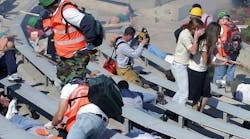Emergency drills may be a nuisance to your employees, but they are paramount to your emergency preparedness. Running a drill is dependent on several factors: your building type, occupancy, identified risks, and the kind of emergency being tested. For example, an active shooter scenario in a 1-story elementary school has different variables than a fire in a 16-story office building.
Related: How to Warn Occupants About an Active Shooter
Simulating a real event is necessary to polish your disaster plans. "If an organization fails to plan, then it is planning to fail," says Sean Ahrens, project manager, security for Aon Risk Solutions.
Theoretical Scenarios
Use tabletop exercises to evaluate your evacuation procedures with your emergency team. By running hypothetical scenarios, you can test for potential glitches and find unaddressed complications.
Related: Emergency Management Planning
"You need to work through the process of what an event will entail and what resources you need to bring to bear," says Ahrens. "Then you anticipate how people are going to go evacuate, where they should go, and how you're going to communicate this to them."
You should also introduce wildcard situations during these theoretical drills. What happens if construction blocks an exit, if a floor monitor is out sick, or someone is on crutches? Test the limits of your plans to ensure they can accommodate multiple variables.
Full-Scale Evacuation
After you refine your emergency plans, put them to the test by running a full-scale evacuation. Impromptu exercises can simulate a real event, while planned drills can coincide with safety-themed months.
"Either way, you don't want to make a drill an event. You want to make it part of your overall safety program," recommends Pete Duncanson, director of training and technical support for disaster restoration with ServiceMaster Clean.
Read also: Mitigate Bomb Threats
A successful drill is dependent on full participation from your occupants. Complacent attitudes during a drill can turn into confusion and risk in a real situation. Make sure your leadership sets a good example to emphasize the importance of drills.
"While your infrastructure and communication might be strong, if people aren't actually participating, then the drill is failing," says Ahrens. "You need to have executive buy-in for these evacuations. CEOs and leadership have a strong opportunity to motivate their employees."
Test Your Equipment
It’s also important to test your emergency equipment and systems. John Stofa, sales manager for Gamewell-FCI, a manufacturer of emergency notification systems, finds that communication systems are often over-tasked.
A flood of information can lead to confusion, particularly if it’s hard to decipher. "A common failure is basic system overloads," explains Stofa. "Are too many messages being sent? Are people not understanding all the messages? Are they not coming in chronological order?"
An FM's Guide to Fire Protection System Inspections
While OSHA and NFPA have set schedules for testing emergency systems, your tenants can give you valuable feedback that a simple equipment test cannot. For example, an echo effect is created from competing sirens, a malfunctioning speaker produces an unintelligible message, or a dead zone exists near loud machinery. "You need to have a layer of many channels, many pathways to talk to people," says Stofa.
Back to Normal
While a drill tests your emergency procedures, you should also assess how to get your occupants back to their normal routines, advises Duncanson. Make sure your drill encompasses responding to the aftermath of an event, such as handling communication, resuming business operations, and resetting equipment.
You also need to complete a thorough write-up of a drill, including statistical data. This information can fine-tune your procedures, confirm the need for equipment purchases, and motivate your employees.
"Feedback is really how you prepare your occupants and evaluate them from the standpoint of 'How can we do this better?'" says Duncanson. "It lets people know this was not just a one-time event. This is a process and part of our natural routine."
Originally written by Jennie Morton who was an assistant editor of BUILDINGS.


